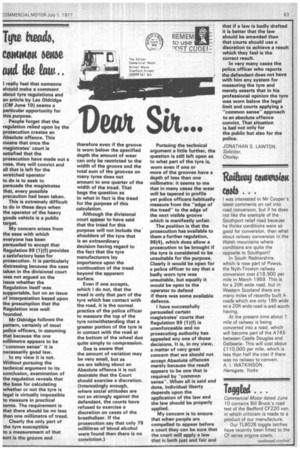Toe ludo, etymon owe and fie Caw..
Page 65

If you've noticed an error in this article please click here to report it so we can fix it.
I really feel that someone should make a comment about tyre regulations and an article by Les Oldridge (CM June 10) seems a particular opportunity for this purpose.
People forget that the regulation relied upon by the prosecution creates an Absolute offence. This means that once the magistrates' court is satisfied that the prosecution have made out a case, they will convict and all that is left for the wretched operator to do is to seek to persuade the magistrates that, every possible precaution had been taken.
This is extremely difficult to do in these days when the operator of the heavy goods vehicle is a public target.
My concern arises from the ease with which everyone has been persuaded to accept that Regulation 99 (1)(f) provides a satisfactory base for prosecution_ It is particularly distressing because the case taken in the divisional court was not argued on the issue whether the Regulation itself was supportable, but on an issue of interpretation based upon the presumption that the Regulation was well founded.
Mr Oldridge follows the pattern, certainly of most police officers, in assuming that because the one millimetre appears to be "common sense" it is necessarily good law.
In my view it is not. Without pursuing the technical argument to its conclusion, examination of the regulation reveals that the base for calculating whether or not the tyre is legal is virtually impossible to measure in practical terms. The requirement is that there should be no less than one millimetre of tread.
Clearly the only part of the tyre susceptible to a measurement of that sort is the groove and therefore even if the groove is worn below the specified depth the amount of wear can only be restricted to the width of the groove and the total sum of the grooves on many tyres does not amount to one quarter of the width of the tread. That begs the question as to what in fact is the tread for the purpose of this calculation.
Although the divisional court appear to have said that the tread for this purpose will not include the shoulders of the tyre that is an extraordinary decision having regard to the fact that the tyre manufacturers lay importance upon the continuation of the tread beyond the apparent surface.
Even if one accepts, which I do not, that the tread is only that part of the tyre which has contact with the road, it is the normal practice of the police officer to measure the top of the tyre notwithstanding that a greater portion of the tyre is in contact with the road at the bottom of the wheel due quite simply to compression.
One is aware that the amount of variation may be very small, but as we are talking about an Absolute offence it is not desirable that the Court should exercise a discretion. (Interestingly enough, where social attitudes are not so strongly against the defendant, the courts have refused to exercise a discretion on cases of the breathaliser. If the prosecution say that only 79 millilitres of blood alcohol were found then there is no conviction.) Pursuing the technical argument a little further, the question is still left open as to what part of the tyre is, worn even if one or more of the grooves have a depth of less than one millimetre: it seems to me that in many cases the wear will be tapered in profile yet police officers habitually measure from the "edge of the tread" to the edge of the next visible groove which is manifestly unfair.
The position is that the prosecution has available to them a further regulation, 99(4), which does allow a prosecution to be brought if the tyre is considered to be unsuitable for the purpose. Clearly it would be open for a police officer to say that a badly worn tyre was unsuitable, but equally it would be open to the operator to defend if there was some available defence.
I have successfully persuaded certain magistrates' courts that Regulation 99 (1)(1) is unenforceable and no prosecuting authority has appealed any one of those decisions. It is, in my view, a matter of very great concern that we should not accept Absolute offences merely because the result appears to be one that is required by "common sense". When all is said and done, individual liberty depends upon the application of the law and the law should be properly applied.
My concern is to ensure that when people are compelled to appear before a court they can be sure that the court will apply a law that is both just and fair and that if a law is badly drafted it is better that the law should be amended than that courts should use a discretion to achieve a result which they feel is the correct result.
In very many cases the police officer who reports the defendant does not have with him any system for measuring the tyre and merely asserts that in his professional opinion the tyre was worn below the legal limit and courts applying a "common sense" approach to an absolute offence convict. That situation is bad not only for the public but also for the police.
JONATHAN S. LAWTON, Solicitor, Charley.








































































































































